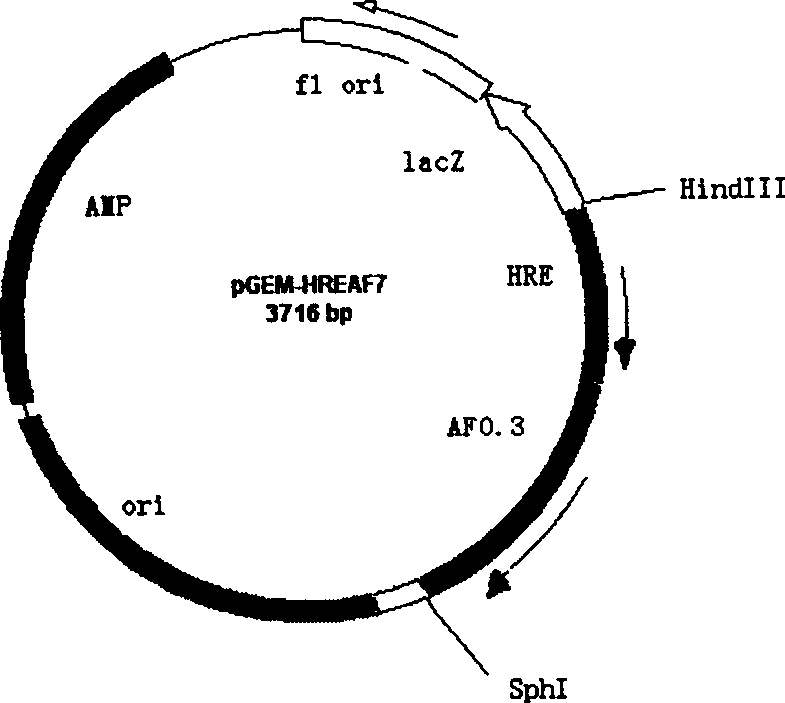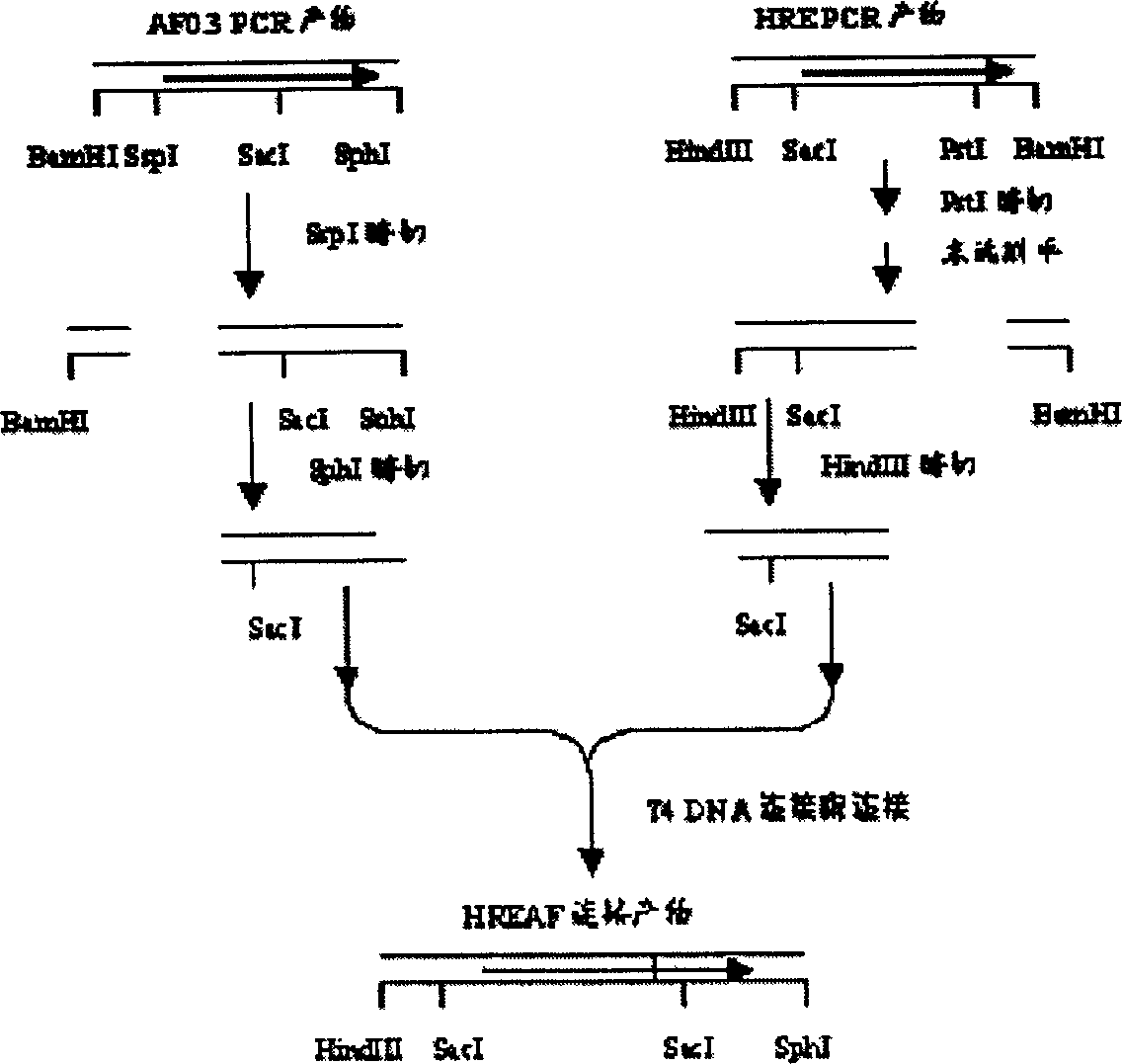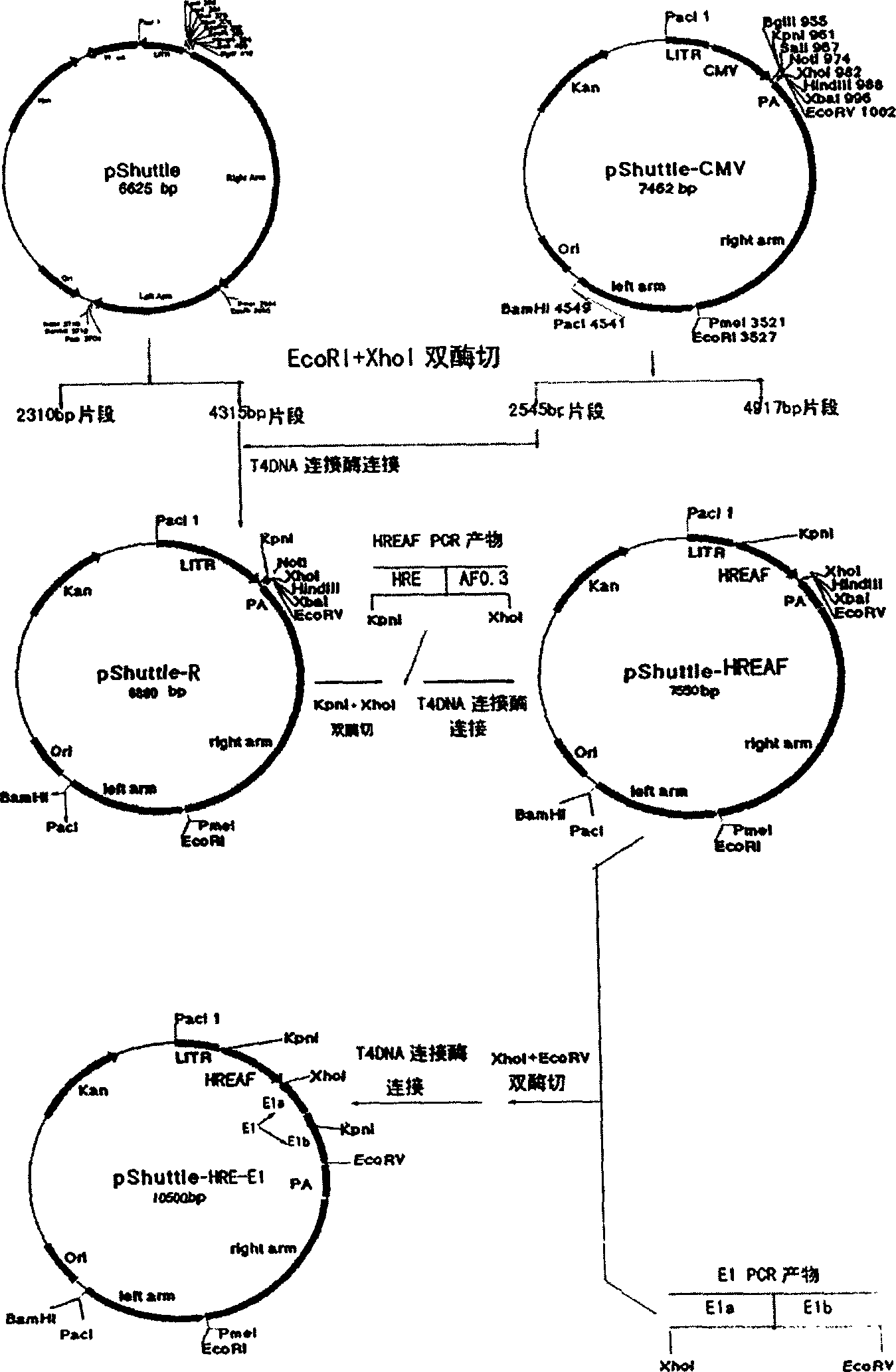Oncolytic adenovirus with target for liver cancer and its preparation method and use
A technology of oncolytic adenovirus and adenovirus, which is applied in the field of recombinant adenovirus, can solve the problems that have not been seen in liver cancer gene therapy of liver cancer, the impact of liver reserve ability, etc., and achieve high safety , high efficiency effect
- Summary
- Abstract
- Description
- Claims
- Application Information
AI Technical Summary
Problems solved by technology
Method used
Image
Examples
Embodiment 1
[0078] Example 1 Cloning of HRE and AF0.3 and Construction of Hybrid Promoter HREAF
[0079] 1. Find out the sequences of human vascular endothelial growth factor VEGF upstream hypoxia response element HRE and human α-fetoprotein core promoter AF0.3 from Genbank, and analyze the internal restriction sites
[0080] (1) For the HRE sequence containing the hypoxia response element, see GenBank data accession no. M63971. The approximately 380 bp DNA fragment between SacI and PstI (1188-1572) in the sequence is the hypoxia response element HRE.
[0081] (2) See GenBank data accession no. L34019 for the sequence containing α-fetoprotein core promoter AF0.3, and the 259 bp DNA fragment between 723 and 981 in the sequence is the AFP core promoter AF0.3. The PCR primers for the hypoxia response element HR and AFP core promoter AF0.3 were designed, and the hypoxia response element HRE primers: see sequence 1 in the sequence listing for the upstream primer, and refer to sequence 2 in...
Embodiment 2
[0100] Example 2 Adenovirus shuttle plasmid pShuttle-HREAF-E1 and
[0101] Construction of pShuttle-HREAF-E1Δ55
[0102] 1. Design the primers required for the construction of the shuttle plasmid
[0103] According to the hypoxia response element HRE (GenBank data accession no.M63971), AFP core promoter AF0.3 (GenBank data accession no.L34019), adenovirus E1a and E1b (GenBank data accession no.X02996) and shuttle reported in the literature Sequences at both ends of the multiple cloning site (MCS) of the plasmid pShuttle (Stratagene website www.stratagene.com), design primers respectively, and add different restriction internals to the 5' end or 3' end of the plasmid depending on the needs of vector construction Dicer sites are used for PCR amplification of each construction element, and primers are synthesized by Sebassen.
[0104] HREAF primers: the upstream primer is shown in sequence 6 in the sequence listing, with a KpnI site added, and the downstrea...
Embodiment 3
[0119] Example 3 Preparation of recombinant oncolytic adenovirus AdhafE1Δ55
[0120] 1. AdEasy XL adenoviral vector system was used to produce recombinant adenovirus ( Figure 5 )
[0121] After the shuttle plasmid was constructed, it was linearized with PmeI, and transformed into BJ5183 (product of Stratagene) competent bacteria together with the backbone plasmid pAdEasy-1. The two plasmids were homologously recombined in the bacteria, and the recombinant adenovirus plasmid was selected by kanamycin resistance, and then identified by PacI digestion in vitro. The recombinant adenovirus plasmid should be digested with PacI to produce a large fragment of about 30kb, and a small fragment of 3.0kb (recombination occurs in the left arm) or 4.5kb (recombination occurs in the pBR322 origin of replication). Recombinant adenovirus plasmids without PacI digestion, on the 0.8% agarose gel electrophoresis band, appear as a fuzzy band at the top near the sample well, and often the...
PUM
| Property | Measurement | Unit |
|---|---|---|
| Titer | aaaaa | aaaaa |
Abstract
Description
Claims
Application Information
 Login to View More
Login to View More - R&D
- Intellectual Property
- Life Sciences
- Materials
- Tech Scout
- Unparalleled Data Quality
- Higher Quality Content
- 60% Fewer Hallucinations
Browse by: Latest US Patents, China's latest patents, Technical Efficacy Thesaurus, Application Domain, Technology Topic, Popular Technical Reports.
© 2025 PatSnap. All rights reserved.Legal|Privacy policy|Modern Slavery Act Transparency Statement|Sitemap|About US| Contact US: help@patsnap.com



